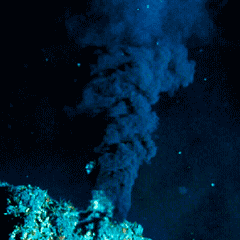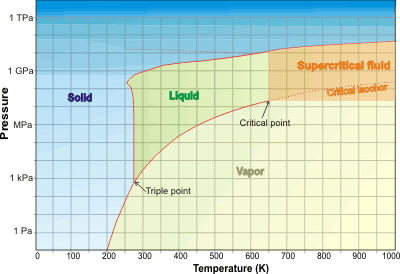
Black smoker chimney showing the exit of
supercritical water, from NOAA

Water is supercritical above its critical point (>647.096 K, >22.064 MPa) where liquid and gas phases cannot be distinguished.
'High temperature aqueous physical chemistry is fertile ground for
scientific and engineering advances'
Ernst Ulrich Franck, 2004
Beyond the critical point (>647.096 K and >22.064 MPa) a in the liquid-vapor space (towards the top right of the water phase diagram below), water is supercritical existing as small but liquid-like hydrogen-bonded clusters dispersed within a gas-like phase [456, 894, 1962], where physical properties, such as gas-like or liquid-like behavior, vary in response to changing temperature, pressure and density and the normal distinction between gas and liquid has disappeared [1766]. At temperatures above the 647.096 K, it is possible to go from vapor-like densities to liquid-like densities without going through a phase transition; i.e., above 647.096 K, water vapor cannot be liquefied by increasing pressure. At the critical point, there is about 30% free monomeric H2O molecules and only about 17% hydrogen-bonding; but this is far greater than in the normal gas phase. It is heterogeneous, and instantaneous properties vary over a wide range between the different structural forms, giving 'average' properties that are, perhaps, not representative. As with other supercritical fluids. supercritical water has no surface tension with its gas or liquid phase or any other supercritical phase as no such interfaces exist.
At the critical point,
![]() and
and ![]()
Water phase diagram showing the supercritical state

The properties of supercritical water are very different from ambient liquid water [3809]. For example, supercritical water is a poor solvent for electrolytes, which tend to form ion-pairs. However, it is such an excellent solvent for non-polar molecules, due to its low relative permittivity (dielectric constant) and poor hydrogen-bonding, that many are completely miscible [3765]. In contrast to ambient liquid water, hydrogen-bonds in supercritical water have broad weak interactions and are not as dynamically rigid and structurally stabilizing even at typical liquid-like densities of about 1000 kg ˣ m-3 [3809]. Viscosity and dielectric both decrease substantially whereas auto-dissociation increases substantially. The physical properties of water close to the critical point (near-critical) are particularly strongly affected [677] by density. Extreme density fluctuations, around the critical point, causes opalescent turbidity. Neutron diffraction has shown that tetrahedral liquid-like states are seen within the supercritical water at above a threshold density, while below this threshold density gas-like water forms small, trigonal, sheet-like configurations [1508].
From the dependence of the frequency maximum of the Raman O-H stretching bands, at about 3500 cm-1, with increasing temperature and pressure, the structure of supercritical water can be divided between three-dimensional and two-dimensional clustering corresponding to liquid- and gas-like states [2896]. No fully-tetrahedral states were found in supercritical water.
Supercritical water has total miscibility with organic fluids and oxygen in supercritical equilibria and presents a reactive environment [1507] capable of oxidizing toxic waste. Under extreme conditions (e.g., 2.38 g cm-3, 3000 K), it may be extremely reactive [1564] causing explosive reactions. The wide range of inorganic material solubility under varying temperature and pressure gives rise to many synthetic processes. As with other supercritical fluids, supercritical water has high compressibility and low viscosity.
Theoretical IR spectra across the Widom line, from [3265]
![Theoretical IR spectra across the Widom line, from [3265] Theoretical IR spectra across the Widom line, from [3265]](images/widom.gif)
The critical isochor (density 322 kg ˣ m-3; shown as the thin dotted line extension in the phase diagram above) may be thought of as dividing more-liquid-like and more-gas-like properties [540]. This isochor is outwardly similar to the loci of the CP maximum, and the thermal expansion and compressibility maxima, (the 'Widom' line [1715]). Above the line is a more 'liquid-like' material and below the line is a more 'gas-like' environment. The shape of the O-H stretch infrared spectral peak changes from Lorentzian to Gaussian and back to Lorentzian across the Widom line [3265] (670 K, see right) with the width of the lineshape displaying a pronounced maximum. This was thought due to an increase in the frequency fluctuations on approaching the Widom line. A further description of the mid-IR spectroscopy of supercritical water is given at [3527].
The Widom lines for isobaric heat capacity, isochoric heat capacity, isothermal compressibility, isobaric thermal expansion, mass density, and the molar internal energy all differ, particularly above 800 K, 100 MPa [1923]. A case has been put proposing a different line (the `Frenkel line') that separates liquid-like and gas-like fluids on their dynamic properties above the critical point [1961 ]; for example, viscosity, the speed of sound, and thermal conductivity all decrease with increasing temperature above the Frenkel line, as in liquids, but increase with temperature when sufficiently below the line, as in gases [1961]. Use of a multi-parameter electronically coarse-grained model for water has shown the presence of both gas-like (dissociated) and liquid-like (associated) water molecules with the density dependence of the molecular dipole moment distinguishing the hydrogen-bond connectivity [2398 ]. Recently, it has been concluded on thermodynamic grounds that the supercritical state is a homogeneous fluid phase where properties change continuously and where the Widom lines are not useful in showing separation between the gas-like and liquid-like water molecules above and below the lines [3416 ].
At about 200 MPa, there is an increase in the interpenetration of hydrogen-bonded networks similar to that occurring at lower sub-critical temperatures [3600]. The phase diagram of water at high pressures and temperatures show a large difference between research teams [3335]. Under the extreme conditions of 1000 K and 11 - 20 GPa supercritical water has a conductivity which is six and seven orders of magnitude larger than at ambient conditions. This has been shown due to rapid molecular dissociation forming short-lived hydroxide, hydronium, Zundel-like H5O2+ and more complex ions with free protons being transient species with lifetimes below 0.3 fs [3335].
[Back to Top ![]() ]
]
a There is some inconsistency in the meaning of 'supercritical' with some referring to conditions above the critical temperature at all pressures whereas others refer to the conditions when both temperature and pressure are above their critical values. [Back]
Home | Site Index | Water phase diagram | Ices, introduction | Ice-Ih | Ice-Ic | Ice-Isd | II | III | IV | V | VI | VII | VIII | IX | X | XI | XII | XIII | XIV | XV | XVI| XVII | XVIII | Amorphous ice | LSBU | Top
This page was established in 2015 and last updated by Martin Chaplin on 15 November, 2019